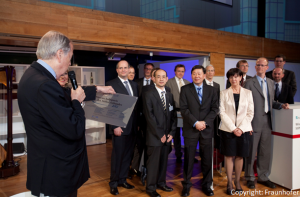Together with several partners from science and industry, EdgeWave received the Stifterverband‘s Science Award 2012. The prize was awarded during the annual meeting of the Fraunhofer Society on May 8, 2012 in Stuttgart in recognition of its outstanding multi-disciplinary collaboration on the InnoSlab laser platform for scaling the power of ultra-short lasers.
The shorter the pulses the preciser a laser tool can work. Another advantage: the processed material is not warmed up, enabling a preciser and gentler processing of highly sensitive materials through a platform which generates ulta-short laser pulses.
The InnoSlab-amplifier – invented by Dr. Du and Prof. Dr. Loosen – is the centerpiece of the InnoSlab platform. Four mirrors surround a laser crystal plate – the slab. A pump jet enters at the two opposite sides of the slab. The mirrors are repeatedly deflected to allow ultra-short laser pulses to keep passing the slab. Each time they do, energy is transmitted from the pump to the laser pulse until the required power is achieved. This platform was developed by the Fraunhofer-Institut for Laser Technology ILT in Aachen and refined further with several partners from industry and science: the chair for laser technology at RWTH Aachen University, the Max Planck institute for Quantum Optics MPQ in Munich and the companies Jenoptik, EdgeWave and Amphos – the last two being ILT spin-offs.
To develop new markets for laser systems with ultra-short wavelengths, the team of had to increase the mean laser output of ultra-short pulse beam sources – up to several hundred watts. Higher power makes higher production volumes in business and shorter measuring times during scientific experiments possible.
Between 2008 and 2011, two joint projects revolved around developing the new beam source: The aim of the PIKOFLAT project, supported by the Federal Ministry for Education and Research BMBF, was to structure pressure tools and embossing rollers. Here the goal was to reduce the processing time and to develop ps-lasers with an average power of 100W respectively 400W. With such ps-lasers it is possible to manufacture embossing rollers and car dashboards in as few as one or two days. In the second joint project, KORONA, Fraunhofer collaborated closely with the Max Planck Institute for Quantum Optics in Garching near Munich and with RWTH Aachen University. The scientists jointly developed a compact beam source whose extremely short-wavelength light makes it possible to examine nano-structures.









